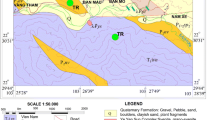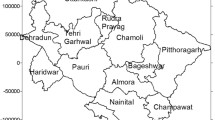Abstract
Concentrations of radon (222Rn) and thoron (220Rn) were measured in the air of different marble factories by using a nuclear track technique. The influence of the marble dust nature and ventilation on radon and thoron concentrations was investigated. It was observed that measured radon and thoron concentration ranged from 310 to 903 Bq m−3 and 6 to 48 Bq m−3, respectively. In addition, alpha-activities due to the unattached and attached fractions of 218Po and 214Po radon short-lived progeny were evaluated in the marble factories studied. Committed equivalent doses due to the attached and unattached fractions of 218Po and 214Po nuclei were evaluated in the lung tissues of marble factory workers. The dependence of the resulting committed equivalent dose on the concentration of the attached and unattached fractions of the 218Po and 214Po radionuclides and mass of the tissue was investigated. The resulting annual committed effective doses to the lung of marble factory workers due to the attached and unattached fractions of the 218Po and 214Po radionuclides were calculated. The obtained results show that about 80% of the global committed effective doses received by workers in the studied marble factories are due to the attached fraction of the 218Po and 214Po radon short-lived daughters from the inhalation of polluted air. Male workers spending 8 h per day (2080 h per year) in a marble factory receive a maximum dose of 34.46 mSv y−1 which is higher than the (3–10 mSv y−1) dose limit interval given by the ICRP. Good agreement was found between data obtained for the average effective dose gotten by using this method and the UNSCEAR and ICRP conversion dose coefficients.



Similar content being viewed by others
References
Abdel Ghany, H. A. (2007). Enhancement of radon exposure in smoking areas. Environmental Geochemistry and Health, 29, 249–255.
Ǻkerblom, G. (1999). Radon legislation and national guidelines. Swedish Radiation Protection Institute. SSI report 99-18, ISSN 0282-4434.
Cucos Dinu, A., Calugar, M. I., Burghele, B. D., Dumitru, O. A., Cosma, C., & Onac, B. P. (2017). Radon levels in Romanian caves: An occupational exposure survey. Environmental Geochemistry and Health, 39, 1085–1099.
Dixon, D. W., Gooding, T. D., & McCreadyShea, S. (1996). Evaluation and significance of radon exposure in British workplace buildings. Environment International, 22, S1079–S1082.
EC. (1997). European Commission, Office for official publication of the European Commission. Recommendations for the implementation of the title VII of the European basic safety standards concerning significant increase due to natural radiation sources, Radiation Protection Series.
Ha, C. M., Chang, S. Y., & Lee, B. H. (1999). Dose assessment to inhalation exposure of indoor 222Rn daughters in Korea. Health Physics, 63, 453–456.
ICRP. (1993). International commission on radiological protection. Protection against radon-222 at home and at work. Ann ICRP 23, No. 2, ICRP publication 65. Oxford: Pergamon Press.
ICRP. (1994). International commission on radiological protection. Human respiratory tract model for radiological protection. Ann ICRP 24, No. 1–3, ICRP publication 66. Oxford: Pergamon Press.
ICRP. (2002). International commission on radiological protection. Basic anatomical and physiological data for use in radiological protection: Reference values. Ann ICRP 32, No. 3–4, ICRP publication 89. New York: Elsevier.
ICRP. (2006). International commission on radiological protection. Human respiratory tract model for radiological protection. Ann ICRP 36, No. 1–2, ICRP publication 100. New York: Elsevier.
ICRP. (2007). International commission on radiological protection. Recommendations of the international commission on radiological protection. Ann ICRP 37, No. 2–4, ICRP publication 103. New York: Elsevier.
Misdaq, M. A., & Amghar, A. (2005). Radon and thoron emanation from various marble materials: Impact on the workers. Radiation Measurements, 39, 421–430.
Misdaq, M. A., Bakhchi, A., Ktata, A., Merzouki, A., & Youbi, N. (1999). Determination of uranium and thorium contents inside different materials using track detectors and mean critical angles. Applied Radiation and Isotopes, 51, 209–215.
Misdaq, M. A., Bakhchi, A., Moustaaidine, H., & Charik, R. (1997). A new method for evaluating alpha dose rates in different building material samples by using solid state nuclear track detectors. Applied Radiation and Isotopes, 48(4), 527–533.
Misdaq, M. A., Chaouqi, A., Ouguidi, J., Touti, R., & Mortassim, A. (2015). Radon and thoron measured in petrol and gas-oil exhaust fumes by using CR-39 and LR-115 II nuclear track detectors: Radiation doses to the respiratory tract of mechanic workers. Health Physics, 108(6), 592–596.
Misdaq, M. A., Elouardi, B., & Ouguidi, J. (2017). 222Rn, 220Rn and their progenies measured in the air of different dwellings and workplaces and resulting alpha radiation doses to the eyes of individuals. Health Physics, 113(5), 363–374.
Misdaq, M. A., Ezzahery, H., & Elbboubi, D. (2001). Determination of equivalent dose rates and committed effective doses in the respiratory system from the inhalation of radon decay products by using SSNTD and a dosimetric compartmental model. Radiation Protection Dosimmetry, 93, 347–355.
Misdaq, M. A., & Flata, K. (2003a). The influence of the cigarette smoke pollution and ventilation rate on alpha-activities per unit volume due to radon and its progeny. Journal of Environmental Radioactivity, 67, 207–218.
Misdaq, M. A., & Flata, K. (2003b). Radon and daughters in cigarette smoke measured with SSNTD and corresponding committed equivalent dose to respiratory tract. Radiation Measurements, 37, 31–38.
Misdaq, M. A., Ghilane, M., Ouguidi, J., & Outeqablit, K. (2012). Radiation doses to individuals due to 238U, 232Th and 222Rn from the immersion in thermal waters and to radon progeny from the inhalation of air inside thermal stations. Radiation and Environmental Biophysics, 51, 375–389.
Misdaq, M. A., Khajmi, H., Aitnouh, F., Berrazzouk, S., & Bourzik, W. (2000). A new method for evaluating uranium and thorium contents in different natural material samples by calculating the CR-39 and LR-115 type II SSNTD detection efficiencies for the emitted α-particles. Nuclear Instruments and Methods in Physics Research, B171, 350–359.
Misdaq, M. A., & Ouguidi, J. (2011). Concentrations of radon, thoron and their decay products measured in natural caves and ancient mines by using solid state nuclear track detectors and resulting radiation dose to the members of the public. Journal of Radioanalytical and Nuclear Chemistry, 287, 135–150.
Porstendörfer, J. (1994). Properties and behaviour of radon and thoron and their decay products in the air. Journal of Aerosol Science, 25(2), 219–263.
Porstendörfer, J., & Mercer, T. T. (1978). Influence of nuclei concentration and humidity upon the attachment rate of atoms in the atmosphere. Atmospheric Environment, 12, 2223–2238.
Rokmy, M., Misdaq, M. A., & Satif, C. (1995). Influence of pollution and building materials on domestic radioactivity in Marrakechi dwellings. Journal of Radioanalytical and Nuclear Chemistry, 190, 51–57.
UNSCEAR. (1993). Sources and effects of ionising radiation. Report to the General Assembly, UN, New York.
UNSCEAR. (2000). Sources and effects of ionising radiation. Report to the General Assembly (Vol. I), UN, New York.
US EPA. (2004). Environments division (6609 J), a citizen’s guide to radon: The guide to protecting yourself and your family from radon, US EPA 402-K-006, Washington DC, USA.
Xie, D., Liao, M., & Kearfott, K. J. (2015). Influence of environmental factors of indoor radon concentration levels in the basement and ground floor of a building—A case study. Radiation Measurements, 82, 52–58.
Yu, K. N., Young, E. C. M., Stokes, M. J., Guan, Z. J., & Cho, K. W. (1997). A survey of radon and thoron progeny for dwellings in Hong Kong. Health Physics, 73, 373–377.
Ziegler, J. F., Biersack, J. P., & Ziegler, M. D. (2013). SRIM. The stopping and range of ions in matter, version 2013. Morrisville, NC: Lulu Press Co.
Acknowledgements
This work was performed under an URAC-15 research contract with the CNRST, Rabat, Morocco.
Author information
Authors and Affiliations
Corresponding author
Additional information
Publisher's Note
Springer Nature remains neutral with regard to jurisdictional claims in published maps and institutional affiliations.
Rights and permissions
About this article
Cite this article
Misdaq, M.A., Talbi, A. & Ouguidi, J. Measurement of radon, thoron and their daughters in the air of marble factories and resulting alpha-radiation doses to the lung of workers. Environ Geochem Health 41, 2209–2222 (2019). https://doi.org/10.1007/s10653-019-00276-9
Received:
Accepted:
Published:
Issue Date:
DOI: https://doi.org/10.1007/s10653-019-00276-9




